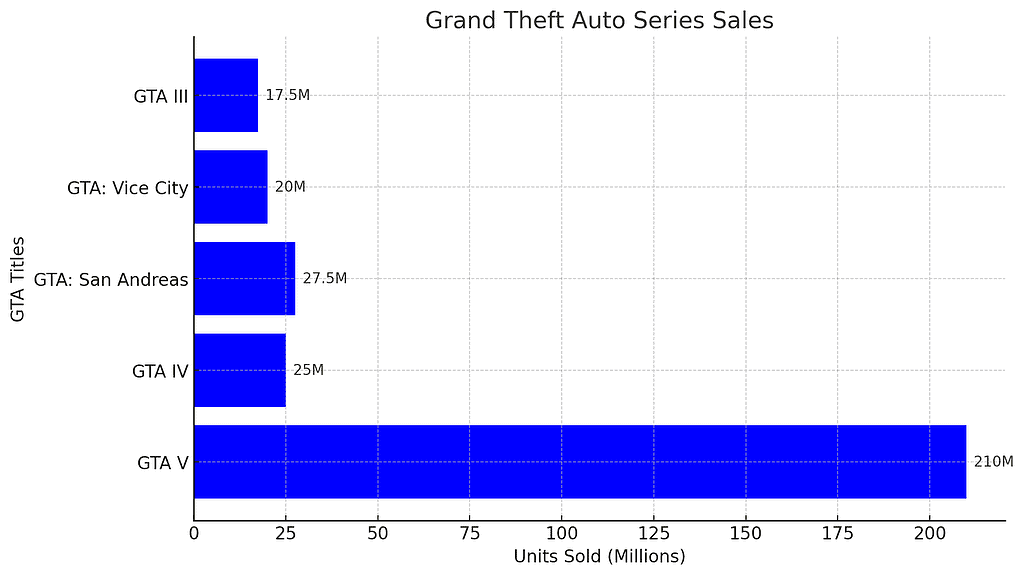The Evolution of Grand Theft Auto: A Look at the Past, Present, and Future of Rockstar’s Blockbuster Series

Updated · Mar 14, 2025


Grand Theft Auto (GTA) has been a cornerstone of the gaming industry since its inception, continually pushing boundaries and setting new standards in open-world gameplay, storytelling, and player freedom. As we anticipate the release of GTA VI, it is essential to reflect on the series’ evolution, the factors influencing its narratives, and the strides Rockstar Games is making toward inclusivity—most notably with the introduction of Lucia, GTA’s first-ever female protagonist.
TABLE OF CONTENTS
The Genesis of Grand Theft Auto
The Grand Theft Auto series began its journey in 1997 when Rockstar Games (then DMA Design) released the first title. The original GTA was a top-down action-adventure game that introduced players to a chaotic open-world experience. Though primitive by today’s standards, it allowed players to navigate three fictional cities (Liberty City, Vice City, and San Andreas), engage in missions, and interact with a dynamic environment.
At its core, the game was about criminal escapades, freedom of choice, and an emergent open world where players could roam at will. Despite its simplistic graphics and gameplay, the foundation for something revolutionary had been laid.
The real breakthrough, however, came in 2001 with GTA III. Rockstar’s decision to transition to a 3D open world was a game-changer. With a fully realized Liberty City, the game offered players an unprecedented level of freedom, allowing them to explore a living, breathing world filled with pedestrians, vehicles, side missions, and an engaging main storyline. The success of GTA III paved the way for the series’ continued dominance, making it one of the most influential video games of all time.
Following this milestone, Rockstar continued to refine and expand the formula with GTA: Vice City (2002) and GTA: San Andreas (2004). Vice City took players to a neon-soaked 1980s Miami-inspired setting, filled with vibrant aesthetics and a narrative heavily inspired by movies like Scarface. San Andreas expanded the world even further, offering an entire state to explore—complete with three distinct cities, a countryside, and even an RPG-style progression system where players could customize the protagonist’s physique, skills, and lifestyle choices.
By the time GTA IV arrived in 2008, the series had shifted toward a more realistic and serious tone, with a heavier emphasis on storytelling. The game introduced players to Niko Bellic, an Eastern European immigrant seeking the American dream in Liberty City, only to become entangled in the underworld of crime and violence. With improved physics, more complex AI, and a deeper narrative, GTA IV cemented Rockstar’s reputation for cinematic storytelling.
However, it was GTA V (2013) that set new records for the industry, both in terms of sales and influence.
The Unprecedented Success of GTA V
When GTA V was released in 2013, it quickly became a cultural phenomenon. With its sprawling open-world depiction of Los Santos (a fictionalized version of Los Angeles), the game pushed the boundaries of what was possible in gaming. Featuring three playable protagonists—Michael, Franklin, and Trevor—the game introduced a multi-perspective storytelling approach that added depth and variety to the gameplay.
The title broke numerous records, earning over $1 billion in revenue within just three days of release. To date, GTA V has sold approximately 210 million copies, making it one of the best-selling video games of all time.
A significant contributor to its longevity has been GTA Online, the game’s multiplayer component. Launched shortly after the base game, GTA Online evolved into a massive, ever-expanding universe filled with new missions, heists, properties, businesses, and player-generated content. Rockstar’s ability to consistently update GTA Online kept the game relevant for over a decade, ensuring GTA V remained a dominant force in the gaming industry.
Now, after more than a decade of anticipation, Rockstar is preparing to redefine the series once again with the upcoming release of GTA VI.
Shifting Trends in Gaming and GTA Storylines
Over the past two decades, gaming has undergone significant transformations, influenced by technological advancements, cultural shifts, and evolving player expectations. These changes have directly impacted the narratives and themes explored in the GTA series.
1. Technological Advancements
The improvements in graphics, AI, and world simulation have allowed developers to create more immersive and detailed open worlds. The evolution from the blocky character models of GTA III to the hyper-realistic environments of GTA V showcases how far technology has come. With GTA VI, Rockstar is expected to push the boundaries even further, leveraging next-gen hardware to create a world that is more dynamic, realistic, and reactive than ever before.
2. Cultural Awareness and Representation
The gaming industry has become increasingly aware of the need for inclusivity and representation. The days of exclusively male protagonists are gradually fading, with more games embracing diverse leads and narratives that reflect a broader range of experiences. While GTA has always featured strong female characters, Lucia’s introduction as the lead protagonist in GTA VI represents a landmark moment for the franchise.
3. Player Expectations
Modern gamers seek richer, more immersive experiences with narratives that resonate on a deeper level. The success of story-driven titles like The Last of Us and Red Dead Redemption 2 has demonstrated the demand for compelling characters and emotional depth. As a result, Rockstar is likely to focus on delivering a more sophisticated and engaging narrative with GTA VI.
Embracing Inclusivity: The Introduction of Lucia
One of the most significant changes coming with GTA VI is the introduction of Lucia, the first female protagonist in the series. This move signifies a step toward greater inclusivity and diversity in gaming.
The Significance of Lucia
Historically, GTA has centered around male protagonists, often depicting women in secondary or supporting roles. With Lucia taking center stage, GTA VI has the potential to challenge traditional gaming norms and introduce fresh storytelling perspectives.
The introduction of a female lead not only broadens the franchise’s appeal but also allows Rockstar to explore new themes and character dynamics. Reports suggest that Lucia will be part of a Bonnie and Clyde-inspired duo, indicating that the game may explore deeper themes of partnership, survival, and trust in the criminal underworld.
Industry Impact
The decision to feature a female protagonist in GTA VI could influence other major franchises to prioritize inclusivity. Just as GTA III revolutionized open-world gaming, GTA VI’s commitment to diversity may set a precedent for character representation in mainstream gaming.
GTA Sales Milestones and Projections for GTA VI
The GTA franchise has consistently shattered sales records, demonstrating its enduring popularity:
- GTA III: ~17.5 million units sold
- GTA: Vice City: ~20 million units sold
- GTA: San Andreas: ~27.5 million units sold
- GTA IV: Over 25 million units sold
- GTA V: 210 million units sold (and counting)

(Source: wikipedia.org/wiki/Grand_Theft_Auto)
Anticipated Success of GTA VI
Industry analysts predict that GTA VI could generate approximately $3.2 billion in its first year, with over $1 billion from pre-orders alone. Given the immense anticipation and Rockstar’s track record, the game is expected to break new ground in both sales and cultural impact.
Continuing the Legacy
The evolution of Grand Theft Auto mirrors the dynamic nature of the gaming industry, adapting to technological innovations, cultural shifts, and the growing call for inclusivity. From the humble top-down days of GTA 1 to the hyper-detailed open world of GTA V, the franchise has continuously redefined what is possible in gaming.
With GTA VI, Rockstar is poised to do it again. The game’s return to Vice City, the introduction of Lucia as a playable protagonist, and the promise of a more immersive world indicate that this will be one of the most ambitious gaming projects ever undertaken.
As we eagerly await the release of GTA VI, one thing is certain: Rockstar Games isn’t just creating another installment—they’re shaping the future of open-world gaming once again.

Tajammul Pangarkar is the co-founder of a PR firm and the Chief Technology Officer at Prudour Research Firm. With a Bachelor of Engineering in Information Technology from Shivaji University, Tajammul brings over ten years of expertise in digital marketing to his roles. He excels at gathering and analyzing data, producing detailed statistics on various trending topics that help shape industry perspectives. Tajammul's deep-seated experience in mobile technology and industry research often shines through in his insightful analyses. He is keen on decoding tech trends, examining mobile applications, and enhancing general tech awareness. His writings frequently appear in numerous industry-specific magazines and forums, where he shares his knowledge and insights. When he's not immersed in technology, Tajammul enjoys playing table tennis. This hobby provides him with a refreshing break and allows him to engage in something he loves outside of his professional life. Whether he's analyzing data or serving a fast ball, Tajammul demonstrates dedication and passion in every endeavor.











